It is best always to buy rather too much than too little [dress fabric]; and to have a piece left, rather than to get a scanty pattern, such as will barely hold out, leaving nothing for repairs or alterations. There is much advantage in getting an extra yard and a half, or two yards, and keeping it back for new sleeves. Unless you are small and slender, it is not well to buy a dress embroidered with a border pattern. They are always scanty in width, and have that look when made up. The skirts are never quite wide enough. A tall woman requires as full a skirt as a fat one; else her height will make her look lanky and narrow. --Eliza Leslie, The Behavior Book (1853), page 75Dresses are another huge topic; this post is more of an introduction than a comprehensive summary. There are any number of "rules", and a similarly large number of exceptions to them. Instead, I'll address some common construction elements, and a few general trends in women's dresses (with some of the reasoning behind them). Ensembles with contrasting skirts and bodices will be handled separately.
For examples of some of these details, see the Kent State University Museum's "Inside Out" page, specifically the 1850s printed wool day dress, and a late war (labelled c. 1864) silk dress. Common construction methods demonstrated include flat-lining on the bodices, a "dog-leg" closure on the wool dress (center front bodice opening + side front skirt opening), boning in the silk bodice, hem facings and applied hem tape, gauged skirts, and pockets set into the skirt seams. Note the small, self-fabric piping and where it's used.
Trend #1: A dress that's meant to be washed will have washable decoration, or none at all. Self fabric is a common option: visual interest can be added with decorative tucks, different components cut in different directions, pleating or shirring that emphasizes different elements of a print/pattern, or even strips of fabric laid on as trim, ruched or flat.
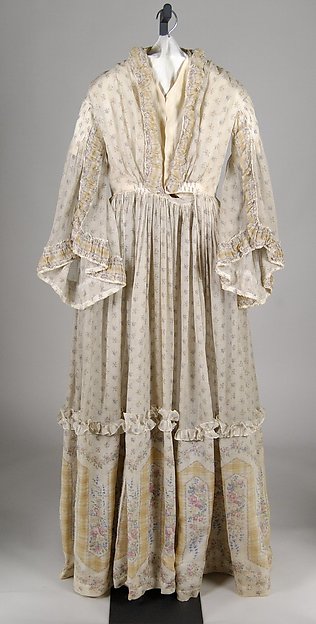 |
| Sheer cotton dress with self-fabric trim c. 1860, at The Met. |
 |
| Silk dress with lace trim and self-fabric trim, c. 1863, from The Met. (Personally, I think it's more likely 1865). |
Cotton skirts are more likely to be gauged rather than pleated. Silk or wool skirts can be gauged, but box or knife pleats are more common. Pleated skirts with dense gauging at the center back are also sometimes seen. Approaching 1865, gored skirts become popular, with additional fullness controlled in pleats. Though not conclusive, I'll observe that gauging "fluffs" the skirt more directly below the waist, while flat pleats lie more compactly--perhaps the gauging is intentionally adding loft to thin/soft-bodied cotton fabric. I've also noticed that gathered and gauged cotton dresses frequently have waistbands. while darted bodices are more likely to have piped waist edges without a waistband. This smooth band of fabric provides a narrow focal point, bordered by the gathered fullness on either side (without it, the dress would look less tidy).
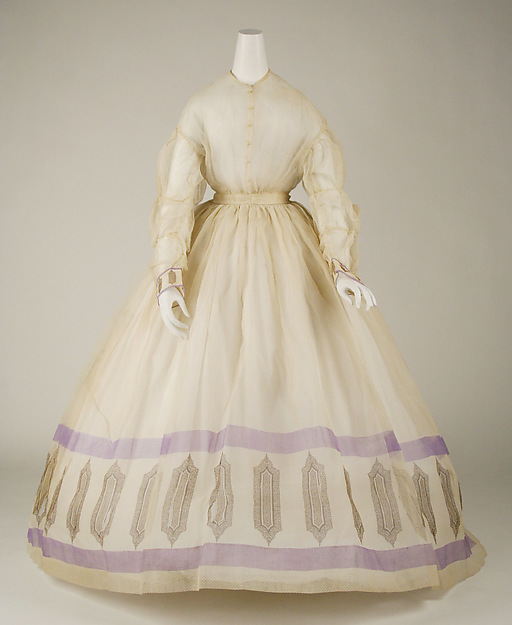 |
| Sheer cotton dress with gathered bodice, waistband and gauged skirt, c. 1860, from The Met. |
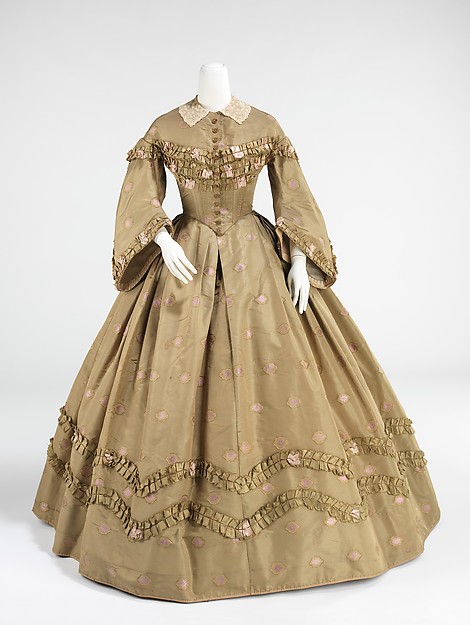 |
| Silk dress, c. 1862, with darted-to-fit bodice and pleated skirt, no waistband. From The Met. |
Trend #3: Women's day dresses of the 1860s tend to have long sleeves, high necklines, and to fasten at the center front. The introduction of the two-piece corset busk, c. 1851, made it considerably easier for women to dress themselves, and women's daywear abruptly shifted from largely back-closures to almost uniformly front-closures. Some evening dresses, specifically ball gowns, held onto the back-openings, also retaining other elements which had passed out of fashion for women's daywear: short sleeves, and open/boat necklines. [These three elements also remained common in children's clothing.] Evening dresses also vary a bit more than daywear in these regards: you'll see plenty of long sleeved, high-neckline "dinner dresses" and "evening dresses", and occasional hybrids such as a low bodice with long sleeves, or with a front opening.
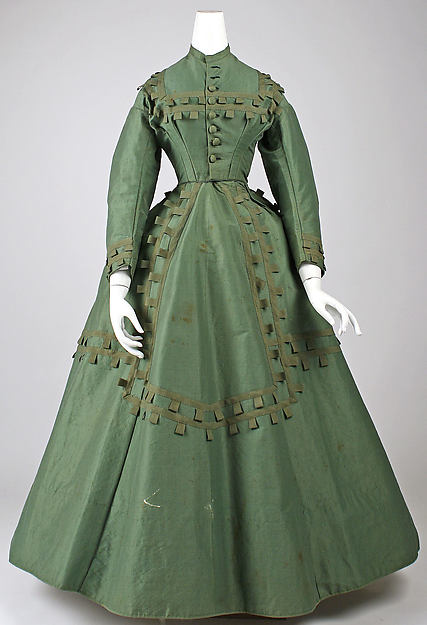 |
| Silk dress appropriate for day wear, with long coat sleeves, darted bodice, and high neckline. The gored skirt is further controlled by pleats. Ribbon trim and fabric-covered buttons. From The Met, c. 1864-5. |
 |
| Silk dress c. 1861-3, from the VAM. The short sleeves, open neck, and back fasteners suggest it is a ball gown. Note the velvet and lace accents: such difficult-to-launder trim is more likely found on a silk dress than a cotton one. |
 |
| Three evening dresses, from Godey's, February 1861. The left-most, a "dinner dress, also suited to a small evening party", has the open neck and back-closure common to ball gowns (with slightly longer short sleeves); "the evening dress for a very young lady" combines long sleeves and an apparent front-closure with a low, square neckline, while the last "dinner dress" has a high neck, front closure, and long sleeves, which would not be out of place on a day dress. |
Trend #4: White accessories (collars, chemisettes, kerchiefs or tuckers at the neck; cuffs or undersleeves at the wrist) tend to be worn for cleanliness: both to promote it and to show it off. Consider your modern laundry: which places on a white dress shirt will start showing wear and discoloration first? Aside from the underarms, the first places to go are the inside collar which touches the neck and the cuffs at the wrist. The wearing life of a dress can be extended by basting onto these vulnerable areas separate articles which can removed, laundered, and replaced as needed. Beautifully washed, blued, starched, and pressed "whites" make one look neat, respectable, and "put together" in the Victorian eye. The white collar also provides a visual buffer between face and dress, moderating the affects of the gown's color on one's complexion.
| Dress with removable white collar and cuffs. From the UK National Trust Collections. |
| Dress with collar and undersleeves, UK National Trust. |
| Open-sleeve dress worn without undersleeves. 1860 self-portrait, UK National Trust. |
Rolled up sleeves and an apron help preserve this
working woman's dress. A kerchief could also be tucked
into the neckline to protect it from sweat and grime.
The Jolly Washerwoman (1851) by Lily Martin Spencer |
Trend #5: Cotton, wool, and silk prints and woven patterns are available in the 1860s. Solid dress fabric is most often wool or silk; cotton being more apt to fade/crock unevenly, solid-colored cottons were very rarely used. The main exception is once again in sheers, such as the white cotton dress under trend #2--a sheer dress will often wear out before such fading becomes apparent, not that fading is an issue for an all white dress. The occasional solid-colored pique or poplin dress is also found, but these are not utilitarian garments, and have more in common with fine casual silks.
 |
| Cotton dress, 1862-1864, from The Met. The pleated skirt, braidwork trim, and solid-colored fabric are more common in silks than cottons. Many cotton dresses are made from printed or pattern-woven materials which obscure uneven fading. |
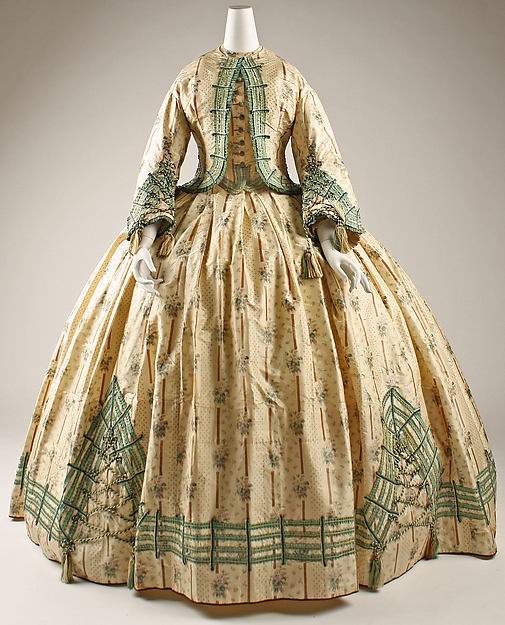 |
| Printed silk dress with contrasting trim, c. 1862, from The Met. |
Perhaps the most important thing is to keep learning: study original garments; read the fashion magazines, sewing manuals and advice books; look at CDVs and paintings (and cartoons, patterns, illustrations, advertisements...).
For those interesting in more resources for making/fitting a dress, see Liz Clark's remarks on altering patterns to fit you (alternatively, buy her book); for more detail on fitting bodices, see "Having a Fit" and "Judicious Padding". "Gauging Skirts" can help with a common treatment of cotton dresses.
For those interesting in more resources for making/fitting a dress, see Liz Clark's remarks on altering patterns to fit you (alternatively, buy her book); for more detail on fitting bodices, see "Having a Fit" and "Judicious Padding". "Gauging Skirts" can help with a common treatment of cotton dresses.

No comments:
Post a Comment